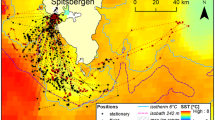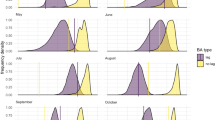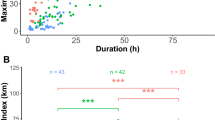Abstract
In order to forage and to provision offspring effectively, seabirds negotiate a complex of behavioural, energetic, environmental and social constraints. In first tests of GPS loggers with seabirds in North America, we investigated the foraging tactics of free-ranging northern gannets (Sula bassana) at a large and a medium-sized colony that differed in oceanography, coastal position and prey fields. Gannets at Low Arctic colony (Funk Island) 50 km off the northeast coast of Newfoundland, Canada provisioned chicks almost entirely with small forage fish (capelin Mallotus villosus, 89%), while at boreal colony (Bonaventure Island) 3 km from shore in the Gulf of St. Lawrence, Quebec, Canada, large pelagic fish dominated parental prey loads (Atlantic mackerel Scomber scombrus 50%, Atlantic herring Clupea harengus 33%). Mean foraging range and the total distance travelled per foraging trip were significantly greater at the larger inshore colony (Bonaventure) than at the smaller offshore colony (Funk Island; 138 and 452 km vs. 64 and 196 km, respectively). Gannets from Funk Island consistently travelled inshore to forage on reproductive capelin shoals near the coast, whereas foraging flights of birds from Bonaventure were much more variable in direction and destination. Birds from the Low Arctic colony foraged in colder sea surface water than did birds from the boreal colony, and dive characteristics differed between colonies, which is concordent with the difference in prey base. Differences between the colonies reflect oceanographic and colony-size influences on prey fields that shape individual foraging tactics and in turn generate higher level colony-specific foraging “strategies”.






Similar content being viewed by others
References
Ainley DG, Ford RG, Brown ED, Suryan RD, Irons DB (2003) Prey resources, competition, and geographic structure of kittiwake colonies in Prince William Sound. Ecology 84:709–723
Ainley DG, Nur N, Woehler EJ (1995) Factors affecting the distribution and size of pygoscelid penguin colonies in the Antarctic. Auk 112:171–182
Birt VL, Birt TP, Goulet D, Cairns DK, Montevecchi WA (1987) Ashmole’s halo: direct evidence for prey depletion by a seabird. Mar Ecol Prog Ser 40:205–208
Cairns DK (1989) The regulation of seabird colony size: a hinterland model. Am Nat 134:141–146
Chardine JW (2000) Census of northern gannet colonies in the Atlantic Region in 1999. Can Wildl Serv Tech Rep Ser 361
Clode D (1993) Colonially breeding seabirds: predators or prey? Trends Ecol Evol 8:336–338
Coulson JC (2002) Colonial breeding in seabirds. In: Schreiber EA, Burger J (eds) Biology of marine birds. CRC Press, Boca Raton, pp 87–113
Davoren GK, Montevecchi WA, Anderson JT (2003) Search strategies of a pursuit-diving marine birds and the persistence of prey patches. Ecol Monogr 73:463–481
Davoren GK, Anderson JT, Montevecchi WA (2006) Shoal behaviour and maturity relations of spawning capelin (Mallotus villosus) off Newfoundland: demersal spawning and diel vertical movement patterns. Can J Fish Aquat Sci 63:268–284
Flemming SP, Greene E (1990) Making sense of information. Nature 348:291–292
Furness RW, Birkhead TR (1984) Seabird colonies distributions suggest competition for food supplies during the breeding season. Nature 311:655–656
Garthe S, Benvenuti S, Montevecchi WA (2000) Pursuit plunging by northern gannets (Sula bassana) feeding on capelin (Mallotus villosus). Proc R Soc Lond 267:1717–1722
Garthe S, Benvenuti S, Montevecchi WA (2003) Temporal patterns of foraging activities of northern gannets Morus bassanus in the north-west Atlantic. Can J Zool 81:453–461
Grémillet D, Dell’Omo G, Ryan PG, Peters G, Ropert-Coudert Y, Weeks SJ (2004) Offshore diplomacy, or how seabirds mitigate intra-specific competition: a case study based on GPS tracking of cape gannets from neighbouring colonies. Mar Ecol Prog Ser 268:265–279
Hamer KC, Phillips RA, Hill JK, Wanless S, Wood AG (2001) Contrasting foraging strategies of gannets Morus bassanus at two North Atlantic colonies: foraging trip duration and foraging area fidelity. Mar Ecol Prog Ser 224:283–290
Holland GJ, Greenstreet SPR, Gibb IM, Fraser HM, Robertson MR (2005) Identifying sandeel Ammodytes marinus sediment habitat preferences in the marine environment. Mar Ecol Prog Ser 303:269–282
Hunt GL Jr (1990) The pelagic distribution of marine birds in a heterogeneous environment. Polar Res 8:43–54
Hunt GL Jr, Eppley ZA, Schneider DC (1986) Reproductive performance of seabirds: the importance of population and colony size. Auk 103:306–317
Kacelnik A, Bernstein C, Krebs JR (1992) The ideal free distribution and predator–prey interactions. Trends Ecol Evol 7:50–55
Kitaysky AS, Golubova EG (2000) Climate change causes contrasting trends in reproductive performance of planktivorous and piscivorous alcids. J Anim Ecol 69:248–262
Lewis S, Sherratt TN, Hamer KC, Wanless S (2001) Evidence for intra-specific competition for food in a pelagic seabird. Nature 412:816–819
Lewis S, Benvenuti S, Dall’Antonia L, Griffiths R, Money L, Sherratt TN, Wanless S, Hamer KC (2002) Sex-specific foraging behaviour in a monomorphic seabird. Proc R Soc Lond 269:1687–1693
Montevecchi WA, Barrett RT, Rikardsen F, Strann KB (1987) Population and reproductive status of gannets in Norway, 1985. Fauna Norv Ser C 10:65–72
Montevecchi WA, Garthe S, Davoren GK (2006) Biophysical influences on seabird trophic assessments. In: Boyd I, Wanless S, Camphuysen CJ (eds) Top predator in marine ecosystems. Their role in monitoring and management. Cambridge University Press, Cambridge, pp 188–130
Montevecchi WA, Myers RA (1995) Prey harvests of seabirds reflect pelagic fish and squid abundance on multiple spatial and temporal scales. Mar Ecol Prog Ser 117:1–9
Montevecchi WA, Myers RA (1996) Dietary changes of seabirds reflect shifts in pelagic food webs. Sarsia 80:313–322
Montevecchi WA, Myers RA (1997) Centurial and decadal oceanographic influences on changes in northern gannet populations and diets in the Northwest Atlantic: implications for climate change. ICES J Mar Sci 54:608–614
Nelson JB (2002) The Atlantic gannet, 2nd edn. Fenix Books, Great Yarmouth
Nettleship DN, Evans P (1985) Distribution and status of the Atlantic Alcidae. In: Nettleship DN, Birkhead TR (eds) The Atlantic Alcidae. Academic, New York, pp 53–154
Shealer DA (2002) Foraging behavior and food of seabirds. In: Schreiber EA, Burger J (eds) Biology of marine birds. CRC Press, Boca Raton, pp 137–177
Stearns SA (1992) The evolution of life histories. Oxford University Press, Oxford
Weimerskirch H (2002) Seabird demography and its relationship with the marine environment. In: Schreiber EA, Burger J (eds) Biology of marine birds. CRC Press, Boca Raton, pp 115–135
Weimerskirch H, Bonadonna F, Bailleul F, Mabille G, Dell’Omo G, Lipp HP (2002) GPS tracking of foraging albatrosses. Science 295:1259
Acknowledgments
This research is a joint German–Canadian collaboration with support from the Natural Sciences and Engineering Research Council of Canada (NSERC), Fisheries and Oceans Canada, and the Research and Technology Centre (FTZ) at Kiel University. We thank Rémi Plourdes and Roger St-Arneault from the Bonaventure Island Provincial Park for logistical support and assistance. Gerrit Peters from earth & Ocean Technologies (Kiel, Germany) provided very valuable technical support. Sven Adler performed the mixed-model analyses. The experiments performed comply with the current laws in Canada.
Author information
Authors and Affiliations
Corresponding author
Additional information
Communicated by O. Kinne, Oldendorf/Luhe.
Rights and permissions
About this article
Cite this article
Garthe, S., Montevecchi, W.A., Chapdelaine, G. et al. Contrasting foraging tactics by northern gannets (Sula bassana) breeding in different oceanographic domains with different prey fields. Mar Biol 151, 687–694 (2007). https://doi.org/10.1007/s00227-006-0523-x
Received:
Accepted:
Published:
Issue Date:
DOI: https://doi.org/10.1007/s00227-006-0523-x




